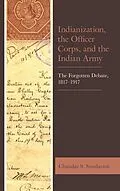**Short-listed for the Society for Army Historical Research UK's Templer Medal Best First Book Prize, 2020** In the Indian Army of the British Raj, the officer corps was "reserved for the governing race"- in other words, the British. Only in 1917, a mere thirty years before India won its freedom, did the Raj permit Indians into the Army's officer corps, thus slowly beginning its Indianization. Yet it is often forgotten that this decision was the culmination of a hundred-year-long debate. Based on meticulous archival research in Britain and India, Indianization, the Officer Corps, and the Indian Army breaks new ground by offering readers the first detailed account of this generally forgotten debate. It traces the myriad schemes and counter-schemes the debate generated, the complex twists and turns it took, and how it engaged both British policymakers anxious to maintain control as well as nationalist Indian leaders agitating for greater self-government. This work also offers insights into the martial races concept, the 1857 uprising, and the impact of Anglo-Indian ideology upon the Indian Army. Clearly written and carefully argued, it is an original and defining contribution to military/war and society history, the history of colonial India and its army, the history of British empire, the history of racism, and civil-military relations.
Autorentext
Chandar S. Sundaram is a scholar of south Asian military history, who has written extensively on the Indian Army, the Indian National Army, and India's post-1947 peacekeeping operations. He presently resides in Victoria, Canada.
Inhalt
Introduction: Defining and Conceptualizing the Forgotten Indianization Debate
Chapter 1: Contexts of the Forgotten Indianization Debate, 16001914
Chapter 2: The Idea of Indianization and its Enemies, 18171898
Chapter 3: The Imperial Cadet Corps: its Formation and Pedagogy, 19001915
Chapter 4: Future Recruitment, Future Employment and the Future of the
Corps, 19021915
Chapter 5: War and the Window of Opportunity, 19141917
Chapter 6: Little Grace in the Giving: Indianization Policy, 19171940
Conclusion: Of Psychological Moments and Persistent Agitation
